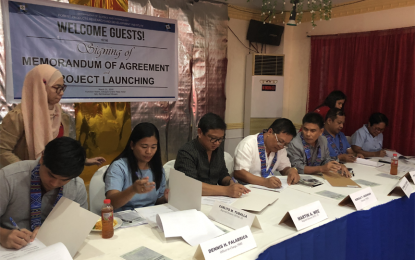
DOST Regional Director Martin Wee (3rd from left), and partner agencies as well as the Tambanan Agrarian Reform Beneficiaires Multipurpose Cooperative sign an agreement for the establishment of a P51.3 milion rubber wood processing center in Naga, Zamboanga Sibugay (Photo courtesy: DOST-9)
ZAMBOANGA CITY --The Department of Science and Tecchnology (DOST) inked a Memorandum of Agreement with a rubber cooperative for the establishment of a PHP51.3-million processing center in Naga, Zamboanga Sibugay.
The project will be implemented through the DOST’s Forest Products Research and Development Institute (DOST-FPRDI) and other concerned government agencies - in partnership with the Tambanan Agrarian Reform Beneficiaries Multipurpose Cooperative (Tarbemco) in Naga town.
DOST Regional Director Martin Wee on Monday said the project will establish a facility, which will process senile and unproductive rubber wood into high-value furniture, moldings, and joineries in the next three years starting this year.
Wee noted that the harvested logs were commonly used for low-value products like pallets, fruit crates, and fuelwood because of the limited knowledge on rubber wood processing, especially on the protection and preservation of quality.
He said that rubber wood or Para rubber (Hevea brasiliensis) is one of the most important agro-forest crops endemic to Southeast and South Asia.
This tree produces latex used in manufacturing car tires and flaps; automotive parts; industrial products like hoses, tubes and belts; consumer products like balls, footwear and erasers; and medical products like gloves and catheters, among others.
The rubber wood has qualities suitable for making furniture and other wooden products.
Wee said the multi-million-peso agreement covers manpower skills training, repair and construction of the processing facility, and purchase of various equipment from DOST-FPRDI, as well as assistance from various collaborating agencies like the Philippine Rubber Research Institute (PRRI), which will help Tarbemco identify senile and unproductive rubber wood trees.
The other signatories of the MOA were the Department of Trade and Industry (DTI), Department of Environment and Natural Resources (DENR), and Technical Education and Skills Development Authority (TESDA).
Wee said the DTI will help Tarbemco with business and entrepreneurial trainings as well as promotions and marketing the rubber wood products in trade fairs.
The DENR will assist them in securing the Environmental Compliance Certificate (ECC) and Wood Processing Permit and other documentary requirements.
The TESDA will facilitate competency standard development and technical vocation trainings.
Tarbemco, the project beneficiary, has 832 hectares of rubber wood plantation and 210 hectares of which are either senile or unproductive.
The potential volume of rubber wood of Tarbemco is around 31,500 cubic meters when harvested based on the 150 cubic meter per hectare ratio. (PNA)
